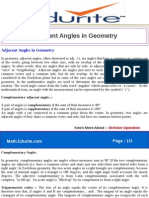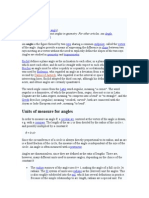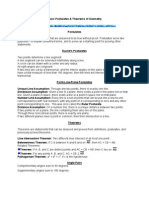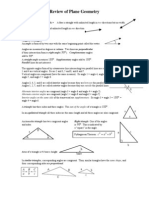Angle Math Definition
Angle Math Definition
Uploaded by
usunomCopyright:
Available Formats
Angle Math Definition
Angle Math Definition
Uploaded by
usunomOriginal Title
Copyright
Available Formats
Share this document
Did you find this document useful?
Is this content inappropriate?
Copyright:
Available Formats
Angle Math Definition
Angle Math Definition
Uploaded by
usunomCopyright:
Available Formats
Acute angle
From Latin: acutus - "sharp, pointed"
Definition: An angle whose measure is less than 90
Try this Adjust the angle below by dragging an orange dot and see how the angle ABC behaves. Note that it is acute for all angles from zero to (but not including) 90
Obtuse angle
From Latin: obtusus - "blunt"
Definition: An angle whose measure is greater than 90 and less than 180
Try this Adjust the angle below by dragging the orange dot at A and see how the angle ABC behaves. Note that it is obtuse for all angles greater than 90 and less than 180
right angle is anangle that bisects the angle formed by two halves of a straight line. More precisely, if a ray is placed so that its endpoint is on a line and the adjacent angles are equal, then they [1] are right angles. As a rotation, a right angle corresponds to a [2] quarter turn (that is, a quarter of a full circle). Closely related and important geometrical concepts are perpendicular lines, meaning lines that form right angles at their point of intersection, andorthogonality, which is the property of forming right angles, usually applied to vectors. The presence of a right angle in a triangle is the defining factor for right [3] triangles, making the right angles basic to trigonometry.
adjacent angles, often shortened as adj. s, are angles that have a common ray coming out of the vertex going between two other rays, with no overlap of the regions "enclosed" by the two angles. In other words, they are angles that are side by side, or adjacent.
Vertical Angle a pair of angles is said to be vertical (also opposite andvertically opposite, which is [1] abbreviated as vert. opp. s ) if the angles are formed from two intersectinglines and the angles are not adjacent. The two angles share a vertex. Such angles are equal in measure and can be described as "equal" (in the UK or the USA) or "congruent" (in the USA).
Complementary angles are angles whose measures sum to 90. If the two complementary angles are adjacent (i.e. have a common vertex and share just one side) their non-shared sides form a right angle. In Euclidean geometry, the two acute angles in a right triangle are complementary, because the sum of internal angles of a triangle is 180 degrees, and the right angle itself accounts for ninety degrees. The adjective complementary is from Latin complementum, associated with the verb complere, "to fill up". An acute angle is "filled up" by its complement to form a right angle.
Supplementary angles are pairs of angles that add up to 180 degrees. Thus the supplement of an angle of x degrees is an angle of (180 x) degrees. If the two supplementary angles are adjacent (i.e. have a common vertex and share just one side), their non-shared sides form a straight line. However, supplementary angles do not have to be on the same line, and can be separated in space. For example, adjacent angles of a parallelogram are supplementary, and opposite angles of a cyclic quadrilateral (one whose vertices all fall on a single circle) are supplementary. If a point P is exterior to a circle with center O, and if the tangent lines from P touch the circle at points T and Q, then TPQ and TOQ are supplementary.
Linear Pair of angles
From Latin: linearis - "belonging to a line"
Definition: Two angles that are adjacent (share a leg) and supplementary (add up to 180)
You might also like
- Vacuum Cleaner, Floor Polisher3Document1 pageVacuum Cleaner, Floor Polisher3usunomNo ratings yet
- Teacher's Resource Book 2Document332 pagesTeacher's Resource Book 2Nauman Iqbal85% (13)
- Geometry Reference: Points, Lines and Planes CirclesDocument2 pagesGeometry Reference: Points, Lines and Planes Circlesmarko1234No ratings yet
- Circle PropertiesDocument17 pagesCircle PropertiesCarl Agape DavisNo ratings yet
- Symfony Cookbook 2.6Document503 pagesSymfony Cookbook 2.6usunomNo ratings yet
- Individual Angles: VertexDocument6 pagesIndividual Angles: VertexBen Aldrian Tariao IbañezNo ratings yet
- Adjacent AnglesDocument3 pagesAdjacent Anglesapi-150539480No ratings yet
- Adjacent Angles GeometryDocument3 pagesAdjacent Angles Geometryapi-174391216No ratings yet
- Adjacent Angles in GeometryDocument3 pagesAdjacent Angles in Geometryapi-174391216No ratings yet
- Adjacent AngleDocument3 pagesAdjacent Angleapi-150539480No ratings yet
- Geometry in The Real WorldDocument21 pagesGeometry in The Real Worldapi-280517624No ratings yet
- Complementary AngleDocument2 pagesComplementary AngleAshwin BrahmaneNo ratings yet
- Plane Shapes1Document5 pagesPlane Shapes1eren2001No ratings yet
- Angle: Units of Measure For AnglesDocument6 pagesAngle: Units of Measure For AnglesashokNo ratings yet
- Angle - WikipediaDocument97 pagesAngle - WikipediaRohit RajNo ratings yet
- Lines and AnglesDocument53 pagesLines and Angleskuppusamy8943No ratings yet
- Ch.21 - Navigational Mathematics PDFDocument12 pagesCh.21 - Navigational Mathematics PDFBechir SamyrNo ratings yet
- Plane Geometry: The Building Blocks of GeometryDocument22 pagesPlane Geometry: The Building Blocks of GeometrySouphia MatteousNo ratings yet
- Bhs Inggris YogiDocument7 pagesBhs Inggris YogiArtemisNo ratings yet
- Basic GeometryDocument11 pagesBasic GeometrySneha chaudhariNo ratings yet
- Trigonometric Functions - Wikipedia, The Free EncyclopediaDocument18 pagesTrigonometric Functions - Wikipedia, The Free Encyclopediadaniyalhassan2789100% (1)
- Geometry Postulates TheoremsDocument4 pagesGeometry Postulates TheoremsCresencio Genobiagon JrNo ratings yet
- Right Angle Perpendicular Orthogonal: Angles ("Obtuse" Meaning "Blunt")Document4 pagesRight Angle Perpendicular Orthogonal: Angles ("Obtuse" Meaning "Blunt")jeoffrey_castroNo ratings yet
- Geometry and TrigonometryDocument6 pagesGeometry and TrigonometryAbhay SoniNo ratings yet
- Geometry TutorialDocument23 pagesGeometry Tutorialtakeiteasy12No ratings yet
- INTRODUCTION GEOMETRY ch4Document24 pagesINTRODUCTION GEOMETRY ch4Jama abdi ibraahim100% (1)
- Types of AnglesDocument3 pagesTypes of Anglesapi-150539480No ratings yet
- Types of AnglesDocument2 pagesTypes of AnglesFauzan BaigNo ratings yet
- Pairs of AnglesDocument4 pagesPairs of AnglesPRINTDESK by Dan100% (1)
- Class IXLines and AnglesDocument40 pagesClass IXLines and AnglesManoj Pandey100% (1)
- ODB - Math (Geometry)Document4 pagesODB - Math (Geometry)Jerric CristobalNo ratings yet
- Geometría en El Plano (Inglés)Document7 pagesGeometría en El Plano (Inglés)Lucía Olmo de la TorreNo ratings yet
- Kuliah 1 - Garis Lurus Dan SudutDocument15 pagesKuliah 1 - Garis Lurus Dan SudutAzwa Nadhira100% (1)
- Trigonometric Functions 2Document34 pagesTrigonometric Functions 2Sahil JindalNo ratings yet
- In Euclidean GeometryDocument32 pagesIn Euclidean GeometryGilar JatisundaNo ratings yet
- Two Radii and A Chord Make An Isosceles TriangleDocument3 pagesTwo Radii and A Chord Make An Isosceles TriangleKael FernandezNo ratings yet
- Charix - Math (1) - 100338Document5 pagesCharix - Math (1) - 100338Error 404No ratings yet
- Basic GeometryDocument24 pagesBasic GeometryEtha Cantik100% (1)
- CIRCLESDocument5 pagesCIRCLESjainmine2010No ratings yet
- Geometry:: Map Bearings, Time Difference and Nautical MilesDocument4 pagesGeometry:: Map Bearings, Time Difference and Nautical MilesMae BeginoNo ratings yet
- Plane Figures and Their PropertiesDocument12 pagesPlane Figures and Their PropertiesSamuel NyanzuNo ratings yet
- Geometry Glossary of TermsDocument8 pagesGeometry Glossary of Termsapi-66400853No ratings yet
- Inbound 7067857925165111838Document16 pagesInbound 7067857925165111838Jacob InfanteNo ratings yet
- Adjacent Angles and Linear Pairs of AnglesDocument2 pagesAdjacent Angles and Linear Pairs of AnglesPercen7No ratings yet
- Circle TheoremDocument8 pagesCircle TheoremJosiah MwashitaNo ratings yet
- Angles and Their MeasuresDocument27 pagesAngles and Their MeasuresMaria Jemimah B. AgravanteNo ratings yet
- Plane and Solid Geometry - 1Document62 pagesPlane and Solid Geometry - 1Regielyn Pagad100% (2)
- Lines and AnglesDocument8 pagesLines and AnglesSajid SheikhNo ratings yet
- MTC 121Document7 pagesMTC 121Rica AlhambraNo ratings yet
- English Task Group 3Document2 pagesEnglish Task Group 3I Gede AriasaNo ratings yet
- Plane GeometryDocument5 pagesPlane GeometryJITENDRA KUMAR SONINo ratings yet
- Basic Geometry GlossaryDocument46 pagesBasic Geometry GlossarydocdocdeeNo ratings yet
- Prepared By: Grade 9-Platinum Submitted To:: Mark Denvir ArquiolaDocument15 pagesPrepared By: Grade 9-Platinum Submitted To:: Mark Denvir ArquiolapersistentengineerNo ratings yet
- Circle GeometryDocument65 pagesCircle GeometrygideonmknNo ratings yet
- Elements of GeometryDocument14 pagesElements of GeometryRyan OlayvarNo ratings yet
- Lines and Angles: by Soumya Sankar Modak Class:-IX - D Roll Number: - 31Document29 pagesLines and Angles: by Soumya Sankar Modak Class:-IX - D Roll Number: - 31Gilbert Guzman TurarayNo ratings yet
- Segments of A CircleDocument25 pagesSegments of A CircleJoyce Estrevencion100% (1)
- Geometry ReviewDocument2 pagesGeometry ReviewJesuv Cristian CleteNo ratings yet
- Pagpili NG Pang Abay Na Pamanahon 11Document29 pagesPagpili NG Pang Abay Na Pamanahon 11Joshua BoncodinNo ratings yet
- Chapter I: Geometric Figures: Definitions, Properties, and RelationshipsDocument26 pagesChapter I: Geometric Figures: Definitions, Properties, and RelationshipsTintin Saints100% (1)
- Lines and AnglesDocument21 pagesLines and Anglespaula bechiNo ratings yet
- The Elements of Euclid for the Use of Schools and Colleges (Illustrated)From EverandThe Elements of Euclid for the Use of Schools and Colleges (Illustrated)No ratings yet
- ADJECTIVEDocument1 pageADJECTIVEusunomNo ratings yet
- Symfony Book 2.6Document234 pagesSymfony Book 2.6usunomNo ratings yet
- All Things Bright Are BeautifulDocument1 pageAll Things Bright Are BeautifulusunomNo ratings yet
- Vacuum Cleaner, Floor PolisherDocument1 pageVacuum Cleaner, Floor Polisherusunom100% (2)
- Vacuum Cleaner, Floor Polisher2Document1 pageVacuum Cleaner, Floor Polisher2usunomNo ratings yet
- Part of SpeechDocument1 pagePart of SpeechusunomNo ratings yet
- Physical EducationDocument3 pagesPhysical EducationusunomNo ratings yet
- The 20 Rules of Subject Verb Agreement in Standard EnglishDocument2 pagesThe 20 Rules of Subject Verb Agreement in Standard EnglishusunomNo ratings yet
- PhysicsDocument1 pagePhysicsusunomNo ratings yet
- Pairs of AnglesDocument2 pagesPairs of AnglesusunomNo ratings yet
- Poem Im Am An African ChildDocument1 pagePoem Im Am An African ChildusunomNo ratings yet
- Elements of Indian MusicDocument1 pageElements of Indian MusicusunomNo ratings yet
- Hinduism Evangelicalism Muslim Budhism Jainism JudaismDocument3 pagesHinduism Evangelicalism Muslim Budhism Jainism JudaismusunomNo ratings yet
- Bone Joints and Their UsesDocument2 pagesBone Joints and Their UsesusunomNo ratings yet
- Issac Newton With PICDocument1 pageIssac Newton With PICusunomNo ratings yet
- Common Laboratory ApparatusDocument3 pagesCommon Laboratory ApparatususunomNo ratings yet
- Balanced ForcesDocument2 pagesBalanced ForcesusunomNo ratings yet
- Countries and Regions of AsiaDocument2 pagesCountries and Regions of AsiausunomNo ratings yet
- Arnold Schoenberg (: ( A ʁnɔlt Ʃø Nbɛʁk) Austrian Expressionist Second Viennese SchoolDocument1 pageArnold Schoenberg (: ( A ʁnɔlt Ʃø Nbɛʁk) Austrian Expressionist Second Viennese SchoolusunomNo ratings yet
- ITMO 2017 - Keystage III - Individual PDFDocument6 pagesITMO 2017 - Keystage III - Individual PDFzarifNo ratings yet
- Maths Reasoning 2022Document28 pagesMaths Reasoning 2022ranjithduttaNo ratings yet
- WS - QP - Cambridge - IX - Math - Sequences and SetsDocument8 pagesWS - QP - Cambridge - IX - Math - Sequences and Setsrudraksh7796No ratings yet
- Geometry From A Differentiable ViewpointDocument322 pagesGeometry From A Differentiable ViewpointEricBS100% (8)
- 9th Heron Formula Proof and Test QuestionsDocument3 pages9th Heron Formula Proof and Test QuestionsAnanthakrishnan Tinneveli VNo ratings yet
- Trigonometry PDFDocument4 pagesTrigonometry PDFJef LoganNo ratings yet
- Summative Test in Mathematics 9Document2 pagesSummative Test in Mathematics 9Ser NardNo ratings yet
- Mathematics HSSC-I (2nd Set)Document9 pagesMathematics HSSC-I (2nd Set)daniyal shahNo ratings yet
- Formulas PDFDocument8 pagesFormulas PDFSubham Paul100% (1)
- Weekly Learning Plan Quarter: 4th Quarter Grade Level: Grade 8 Week: Learning Area: Mathematics MELC/s: PSDocument3 pagesWeekly Learning Plan Quarter: 4th Quarter Grade Level: Grade 8 Week: Learning Area: Mathematics MELC/s: PSLorie Grace Catalogo BaguioNo ratings yet
- 2 VectorsDocument44 pages2 VectorsNurul AtikaNo ratings yet
- Model Test Paper - 2 (Solved) : Maximum Marks: 90 Maximum Time: 3 HoursDocument10 pagesModel Test Paper - 2 (Solved) : Maximum Marks: 90 Maximum Time: 3 Hoursrita soniNo ratings yet
- IDEA Math Admissiontest08Document9 pagesIDEA Math Admissiontest08gauss202No ratings yet
- Mathematics For Grade 3 TeachersDocument16 pagesMathematics For Grade 3 TeachersLyn Español100% (2)
- Lesson 1: Thales' Theorem: Abc A B C AB A B C AB AbcDocument14 pagesLesson 1: Thales' Theorem: Abc A B C AB A B C AB AbcJeff DomNo ratings yet
- CombinepdfDocument85 pagesCombinepdfDhrisha GadaNo ratings yet
- IGCSE Maths 5080 SOW Core 2 YearsDocument18 pagesIGCSE Maths 5080 SOW Core 2 YearsYenny TigaNo ratings yet
- Learners Math Handouts Part IDocument13 pagesLearners Math Handouts Part IDark ShadowNo ratings yet
- Pre Board II Maths Set-B 05.02.2024Document5 pagesPre Board II Maths Set-B 05.02.2024abhinavsinghbaliyanraghuvanshiNo ratings yet
- A Geometric Proof of The Thales' Theorem (And MathJax and Blogger)Document4 pagesA Geometric Proof of The Thales' Theorem (And MathJax and Blogger)Yatharth Agarwal0% (1)
- Gurukul Bharat Dpp:-Complex No: (Problems Based On Fundamentals)Document7 pagesGurukul Bharat Dpp:-Complex No: (Problems Based On Fundamentals)Kumar AtthiNo ratings yet
- F.1 LSC Math UT2 17-18Document6 pagesF.1 LSC Math UT2 17-18Ching Yan CheungNo ratings yet
- 00000376-01 # ASSINGEMENT - N-TNPS, TOPS - Student PDFDocument6 pages00000376-01 # ASSINGEMENT - N-TNPS, TOPS - Student PDFMr. DevilNo ratings yet
- Trigonometry 40 MarksDocument2 pagesTrigonometry 40 MarksSanjay NayakNo ratings yet
- Geometry ExercisesDocument12 pagesGeometry Exercisesann millendezNo ratings yet
- Compositionalschemes PDFDocument75 pagesCompositionalschemes PDFanon_815622130No ratings yet
- Activity 2. Taping Over An ObstacleDocument2 pagesActivity 2. Taping Over An ObstaclePaul Agustin Beseos SincoNo ratings yet
- Watanabe 1981Document4 pagesWatanabe 1981DANIEL ARTEAGA MENDOZANo ratings yet
- SineDocument4 pagesSineGina KhalilNo ratings yet














































































































